Related Research Articles
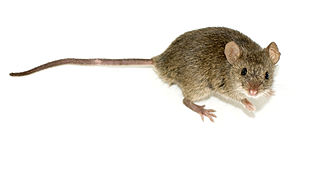
A mouse is a small rodent. Characteristically, mice are known to have a pointed snout, small rounded ears, a body-length scaly tail, and a high breeding rate. The best known mouse species is the common house mouse. Mice are also popular as pets. In some places, certain kinds of field mice are locally common. They are known to invade homes for food and shelter.

Rats are various medium-sized, long-tailed rodents. Species of rats are found throughout the order Rodentia, but stereotypical rats are found in the genus Rattus. Other rat genera include Neotoma, Bandicota and Dipodomys.

The brown rat, also known as the common rat, street rat, sewer rat, wharf rat, Hanover rat, Norway rat and Norwegian rat, is a widespread species of common rat. One of the largest muroids, it is a brown or grey rodent with a body length of up to 28 cm (11 in) long, and a tail slightly shorter than that. It weighs between 140 and 500 g. Thought to have originated in northern China and neighbouring areas, this rodent has now spread to all continents except Antarctica, and is the dominant rat in Europe and much of North America. With rare exceptions, the brown rat lives wherever humans live, particularly in urban areas.
The National Institute of Mental Health (NIMH) is one of 27 institutes and centers that make up the National Institutes of Health (NIH). The NIH, in turn, is an agency of the United States Department of Health and Human Services and is the primary agency of the United States government responsible for biomedical and health-related research.
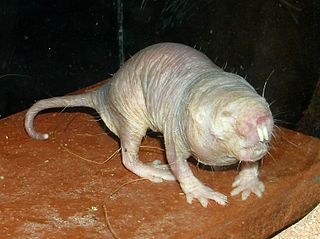
The naked mole-rat, also known as the sand puppy, is a burrowing rodent native to the Horn of Africa and parts of Kenya, notably in Somali regions. It is closely related to the blesmols and is the only species in the genus Heterocephalus.

The house mouse is a small mammal of the order Rodentia, characteristically having a pointed snout, large rounded ears, and a long and almost hairless tail. It is one of the most abundant species of the genus Mus. Although a wild animal, the house mouse has benefited significantly from associating with human habitation to the point that truly wild populations are significantly less common than the semi-tame populations near human activity.
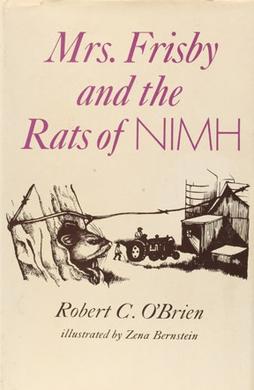
Mrs. Frisby and the Rats of NIMH is a 1971 children's science fiction/fantasy book by Robert C. O'Brien, with illustrations by Zina Bernstein. The novel was published by the Los Angeles publishing house Atheneum Books.

The Muridae, or murids, are either the largest or second-largest family of rodents and of mammals, containing approximately 870 species, including many species of mice, rats, and gerbils found naturally throughout Eurasia, Africa, and Australia.

The Old World rats and mice, part of the subfamily Murinae in the family Muridae, comprise at least 519 species. Members of this subfamily are called murines. In terms of species richness, this subfamily is larger than all mammal families except the Cricetidae and Muridae, and is larger than all mammal orders except the bats and the remainder of the rodents.

A fancy mouse is a domesticated form of the house mouse, one of many species of mice, usually kept as a type of pocket pet. Fancy mice have also been specially bred for exhibiting, with shows being held internationally. A pet mouse is inexpensive compared to larger pets, and even many other pet rodents, but mice are comparatively short-lived: typically only 2 to 3 years.

Laboratory rats or lab rats are strains of the rat subspecies Rattus norvegicus domestica which are bred and kept for scientific research. While less commonly used for research than laboratory mice, rats have served as an important animal model for research in psychology and biomedical science.
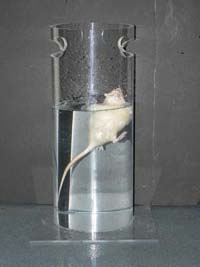
The behavioural despair test is a test, centered on a rodent's response to the threat of drowning, whose result has been interpreted as measuring susceptibility to negative mood. It is commonly used to measure the effectiveness of antidepressants, although significant criticisms of its interpretation have been made.
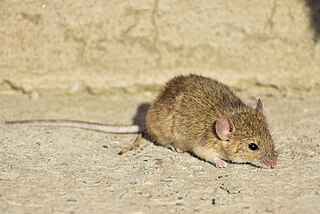
Fear of mice and rats is one of the most common specific phobias. It is sometimes referred to as musophobia or murophobia, or as suriphobia, from French souris, "mouse".

John Bumpass Calhoun was an American ethologist and behavioral researcher noted for his studies of population density and its effects on behavior. He claimed that the bleak effects of overpopulation on rodents were a grim model for the future of the human race. During his studies, Calhoun coined the term "behavioral sink" to describe aberrant behaviors in overcrowded population density situations and "beautiful ones" to describe passive individuals who withdrew from all social interaction. His work gained world recognition. He spoke at conferences around the world and his opinion was sought by groups as diverse as NASA and the District of Columbia's Panel on overcrowding in local jails. Calhoun's rat studies were used as a basis in the development of Edward T. Hall's 1966 proxemics theories.

The large Japanese field mouse is a nocturnal species of rodent in the family Muridae. It is endemic to Japan.

Rodents are mammals of the order Rodentia, which are characterized by a single pair of continuously growing incisors in each of the upper and lower jaws. About 40% of all mammal species are rodents. They are native to all major land masses except for New Zealand, Antarctica, and several oceanic islands, though they have subsequently been introduced to most of these land masses by human activity.

The rotarod performance test is a performance test based on a rotating rod with forced motor activity being applied, usually by a rodent. The test measures parameters such as riding time (seconds) or endurance. Some of the functions of the test include evaluating balance, grip strength and motor coordination of the subjects; especially in testing the effect of experimental drugs or after traumatic brain injury.
Interior design psychology is a field within environmental psychology, which concerns the environmental conditions of the interior. It is a direct study of the relationship between an environment and how that environment affects the behavior of its inhabitants, intending to maximize the positive effects of this relationship. Through interior design psychology, the performance and efficiency of the space and the well-being of the individual are improved. Figures like Walter Benjamin, Sigmund Freud, John B. Calhoun and Jean Baudrillard have shown that by incorporating this psychology into design one can control an environment and to an extent, the relationship and behavior of its inhabitants. An example of this is seen through the rat experiments conducted by Calhoun in which he noted the aggression, killing and changed sexual tendencies amongst rats. This experiment created a stark behavioral analogy between the rat's behavior and inhabitation in high-rise building projects in the US after WWII, an example of which is the Pruitt-Igoe development in St Louis demolished in 1972 only 21 years after being erected.

In behavioral science, a T-maze is a simple forked passage used in animal cognition experiments. It is shaped like the letter T, providing the subject, typically a rodent, with a straightforward choice. T-mazes are used to study how the rodents function with memory and spatial learning through applying various stimuli. Starting in the early 20th century, rodents were used in experiments such as the T-maze. These concepts of T-mazes are used to assess rodent behavior. The different tasks, such as left-right discrimination and forced alternation, are mainly used with rodents to test reference and working memory.

Mrs. Brisby is a fictional field mouse and the protagonist of the 1982 animated adventure film The Secret of NIMH, directed by Don Bluth. Adapted from the 1971 children's novel, Mrs. Frisby and the Rats of NIMH, in which she is originally named "Mrs. Frisby", she is voiced by Elizabeth Hartman in her final film role, who, by her own accord, made the character sound shy and timid. She was originally named "Mrs. Frisby" during the production of the film, like the book character, but was renamed due to a copyright issue with the toy name "Frisbee" from the company Mattel.
References
- ↑ Hall, Edward, T. (1966). The Hidden Dimension: An Anthropologist Examines Humans' Use of Space in Public and in Private. Anchor Books. p. 25. ASIN B0006BNQW2.
{{cite book}}: CS1 maint: multiple names: authors list (link) - 1 2 Calhoun, John B. (1962). "Population density and social pathology" (PDF). Scientific American. 206 (3): 139–148. doi:10.1038/scientificamerican0262-139 (inactive 31 January 2024). PMID 13875732. Archived (PDF) from the original on 2019-11-21. Retrieved 2015-12-14.
{{cite journal}}: CS1 maint: DOI inactive as of January 2024 (link) - ↑ Hock, Roger R. (2004). Forty Studies that Changed Psychology : Explorations into the History of Psychological Research (5th ed.). Prentice Hall. ISBN 978-0-13-114729-4.
- 1 2 3 "The Behavioral Sink". Cabinet Magazine. Summer 2011. Archived from the original on 2020-02-15. Retrieved 2012-08-24.
- ↑ Medical Historian Examines NIMH Experiments in Crowding Archived 2013-03-27 at the Wayback Machine , nih record, 2013-10-13.
- 1 2 3 Calhoun, J. B. (1973). "Death squared: The explosive growth and demise of a mouse population". Proceedings of the Royal Society of Medicine. 66 (1 Pt 2): 80–88. doi:10.1177/00359157730661P202. PMC 1644264 . PMID 4734760.
- ↑ NLM Announces the Public Release of the Papers of John B. Calhoun Archived 2018-09-11 at the Wayback Machine , U.S. National Library of Medicine, 2013-10-13.
- ↑ Ramsden, Edmund and Jon Adams. 2009. Escaping the Laboratory:The Rodent Experiments of John B. Calhoun & Their Cultural Influence, p.22. Archived 2021-03-28 at the Wayback Machine
- ↑ Garnett, Carla. (2008). Plumbing the 'Behavioral Sink', Medical Historian Examines NIMH Experiments in Crowding. Archived 2020-08-15 at the Wayback Machine . NIH Record. Retrieved 2013-07-07.
- ↑ Freedman, Jonathan (November 1975). "Population density and pathology: Is there a relationship?". Journal of Experimental Social Psychology. 11 (6): 539–552. doi:10.1016/0022-1031(75)90005-0.
- ↑ Ramsden, Edmund; Adams, Jon (2009). "Escaping the Laboratory: the rodent experiments of John B. Calhoun & their cultural influence" (PDF). Journal of Social History. 42 (3): 761–797. doi:10.1353/jsh/42.3.761. Archived (PDF) from the original on 2019-11-21. Retrieved 2019-08-12.
- ↑ Gooderham, Mary; Toronto, University of. "Debunking the 'population bomb'". phys.org. Retrieved 2024-02-21.
- ↑ Follett, Chelsea (January 5, 2023). "Defuse the Population Bomb Narrative before It's Too Late". Cato Institute. Retrieved February 21, 2024.
- ↑ Haberman, Clyde (2015-05-31). "The Unrealized Horrors of Population Explosion". The New York Times. ISSN 0362-4331 . Retrieved 2024-02-21.
- ↑ Jaffe, A. J. (1942). "Urbanization and Fertility". American Journal of Sociology. 48 (1): 48–60. doi:10.1086/219078. ISSN 0002-9602. JSTOR 2769969. S2CID 144416655.
- ↑ Population, National Research Council (US) Committee on; Casterline, John B. (2001), "Mass Media and Fertility Change", Diffusion Processes and Fertility Transition: Selected Perspectives, National Academies Press (US), retrieved 2024-02-21
- ↑ Spandrell (March 26, 2013). "Lee Kuan Yew drains your brains for short term gain". Bloody shovel. Archived from the original on 11 October 2015. Retrieved February 21, 2024.